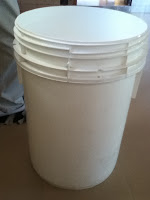It is the season of Rambutan (It is pronounced as Rum-bṹ-tan.), a local tropical fruit in Malaysia.
Let me briefly explains it's physical appearance. According to Merriam-Webster dictionary, it is a bright reed spiny Malayan fruit that is closely related to the lychee. This fruit tree is also known as Nephelium lappaceum, which is a member of the soapberry family. This fruit is popular in south-east Asia due to it's sweetness and juiciness. The inner white flesh tastes as refreshing as a Lychee fruit. However, do restrain yourself from swallowing the big seed in each fruit. The Rambutan tree in my backyard was fully red as it was full of fruits. We decided to brew some Rambutan wine.
We washed the fruits to make sure they are clean and removed the thick spiny skins from the Rambutans. It was tricky as you need to twist the fruit in opposite directions with both hands to open the fruit. For brewing, we only need to use the inner flesh of the fruits, so we removed the seeds too.
It is blending time. We started by filling half of the blender with the white flesh and blend for approximately 5 minutes or until the fruits were in smooth liquid form. Since the fruit itself contained enough juice to help in blending, no additional water is necessary. We made a huge pot of Rambutan juice.
We brought the pot to a boil with small fire. Reminder: Do remember to keep stirring the juice with a bamboo ladle to prevent the bottom part from getting burnt. The burnt part will cause bitterness and affect the whole pot. It was rather tough to stand by the stove and stirring constantly, especially with the size of 6-gallons pot. We added in some sugar and a little citric acid (about ¾ a cup), instead of preservatives, in hoping to keep the pot of Rambutan juice longer. This stirring took us for about 2 to 3 hours before the juice came to a boil. The fruity smell was pretty mild as the Rambutan itself does not have a strong smell, unlike other fruits such as orange with it's citrus smell. We removed it from the heat and cover it. We set the pot aside to cool down. After cooling down to room temperature, we took some for the brewing purpose and refrigerate the rest for future uses.



After 2 hours, we went to check if the pot of Rambutan mash has cooled down. However, it was still too hot to add in yeast. Therefore, we added more cool water into a 5-gallon fermenting bin before pouring in the Rambutan mash. This fermenting bin consists of a air-lock (also named as fermentation trap or 'bubbler'), which is a gadget to protect the fermentation from infection by the vinegar fly. The exact measurements for the total body of water plus Rambutan liquor are:
5.7litres of water + 5.7litres of Rambutan liquor = 11.4litres.
Yet, we leave it in the bin to cool down further…


It is stated, from a winemaking book, that half a level teaspoon of yeast nutrient, which is Ammonium phosphate, (NH4)3PO4 is added to every 4.5litres to give yeast a 'boost'. The purpose of this nutrient is to obtain the best possible fermentation, like the majority of living organisms, need both food and oxygen, to be 'healthy'.
11.4litres/4.5litres = 2.53, which is more than a teaspoon was added into the mash. We have not added the yeast into the mixture because the heat will kill the yeast.
The pictures shown above were the litmus papers to test acidity and the yeast was on the right side.
After an hour, the temperature of the liquor is right to add in yeast. Before that, we used a acidity tester to test the pH of the mash, which showed a pH of 4. It was an acceptable acidity. We added 4 teaspoon of yeast in and gave it a stir before locking the cover. Thus, the fermentation process has begun.
Here was how the mash looked like before I cover it up with the air-lock.
Hopes the fermentation turns out well..







I just made my rambutan wine last night. I got 2 galoon. It's my first time to make. I hope that it will give me.a good result.
ReplyDeleteSweet. I love to hear the results!
DeleteThis comment has been removed by the author.
ReplyDelete